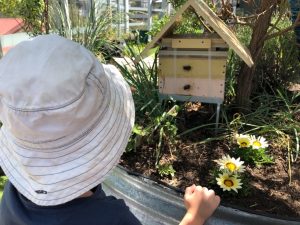
Around this time two years ago, our Stingless Native Bee Hive arrived and our little school on the roof became obsessed!
As I write this 2021, I cannot help but reflect on how much this little box in the garden has influenced the choices we have made the past two years. Everything from the plants we choose for the garden, to the curriculum directions we take.
Tragedy struck late 2020 in the form of a Hive Beetle invasion. All our bees died. We were devastated. We have plans to re-establish our hive on the roof and continue to support the plants of Annandale to pollinate.
Below is a couple of reflections taken from our book VivE&D Pollinators 2019, that documented the learning and exhibition held on the 6th July 2019. You will also find some fabulous examples of video art and film making created by the children. Enjoy!

What happens when you introduce a Native Stingless Bee Hive to your Early Learning Garden?
Curriculum Reflection by Melanie Elderton; Educational Leader
June 2019
On a hot and humid day in January a delivery arrived. A big cardboard box marked FRAGILE. Su and I excitedly cut away the packing tape to reveal a plain wooden box. Our Native Stingless bees had arrived!
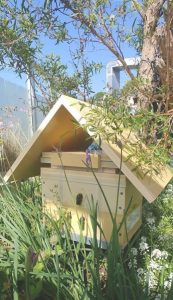
We had no idea how these little black flying creatures would influence our curriculum design across our learning groups.
Flash forward six months and our children are not only entomologists specialising in Australian native bees, they also hold a collective knowledge base that tells us about the anatomy of flowers, the process of pollination and the importance of native wildlife for pollination. They are expressing their connection to nature and Gadigal land through their learning.
Our curriculum has become the ‘bee-curriculum’. We have studied them in our garden and learned about other native bees. Did you know we have teddy bear bees and blue banded bees in our garden? We have drawn bees, sculpted bees from clay and sewn bee costumes. They have been our literacy program too as our shelves became loaded with all different bee books.
This learning led us to wanting to know more about other creatures that help pollinate our plants and soon birds, butterflies, ladybugs and bats became of interest. Flowers were dissected as we worked to gain knowledge. What were the different bits and what do they do? What role do flowers play in making new plants?

The children’s thirst for ‘pollinator knowledge’ led to co-constructed research between the educators and children. The initial enthusiastic interest from the pre-schoolers soon infected the other learning groups.
We supported the scientific community’s knowledge building, participating in the National Pollinator Count and contributing our findings to the data. Even our youngest children were able to identify the different birds and insects that were visiting their garden and contributed to our count.
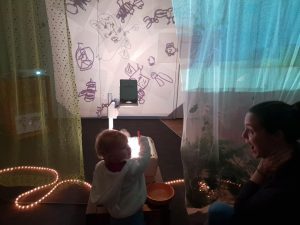
The Buzz about Bees
Exhibition Reflection by Su
Providing the space and time to wonder and to create is what projects are about. Projects are the essence of knowledge creation at Explore & Develop Annandale. The Pollinators project evolved effortlessly and at the end of 2019 when our community was immersed in a brand new world of bees, flowers and other insects.

How did we not know how many creatures were pollinators? How did we not know how many native pollinators were living in our yard? How had we not noticed in the past? There is joy in learning with children; investigating and discovering in collaboration.

Our project exhibition “VIVE&D Pollinators” was held on the 6th July 2019, providing children with the platform to share their learning with their families via 14 pieces of art; including video making, textile art and sculptures. Each child had a part in several project pieces which allowed them to express their knowledge of pollinators into a tangible piece of art.
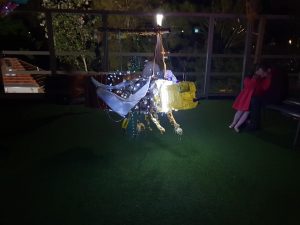
VivE&D is a great time of excitement for our whole community. Children entered the school with their families on a Saturday evening to a whole new environment. The staircase full of art, children’s voices and the buzzing of bees, classrooms filled with projections and light, movies inside and out, and sculptures illuminated.
Parents, grandparents and friends moved through the spaces guided by their child, moving from one artwork to another. Sitting on cushions to watch a movie, moving slowly through sheer curtains hung in several directions throughout a classroom, and stopping to play interactive games on table tops.

This book is an extended version of the exhibition catalogue created for VivE&D. It is the explanation of the children’s work for their sculptures and
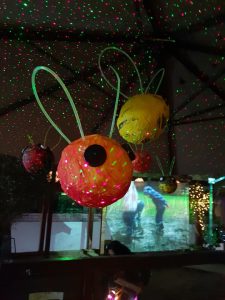
videos. The videos created for the exhibition have been embedded in the book, which you can access using a QR code reader.
To see this work held together in one place, to see the learning, not just about pollinators, but about creating, making, wondering and thinking is inspiring to all of us.
A big thank you to our community who support us, to Ian who helps bring our technological requests to life and to Jessica Staines who is always a mentor to us.

My heartfelt thanks to the wonderful team of educators who encourage ideas and thinking, the biggest thank you, you are all a joy to work with each day.
You can purchase the Pollinators at the Explore & Develop Annandale Facebook page shop. The book documents the learning leading up to, and reflects on the night of the exhibition. It includes a wonderful foreword written by PHD candidate Kathy Gelding, who was completing her field research with us at the time. It also features QR codes that link to the many videos created by the children that featured in the exhibition.
Here some sneak peeks of some video installations that were featured on the night.
The Life Cycle of a Bee– stop motion drawing animation by the Possums 2019
Pollination- Stop Motion photography by the Wombats 2019
Hungry Caterpillar by the Koalas 2019